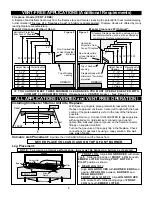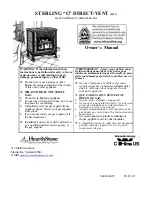
NORMAL OPERATING CHARACTERISTICS
Each and every CHILLBUSTER that leaves the factory is quality checked to ensure compliance with our
American Gas Association certification. This check includes an operational test to ensure both satisfactory
combustion and proper operation.
Each installation site for any vent free heater presents its own unique combustion environment. Specific factors
such as weather tightness of the
home, size of the room in which
the heater is installed, central
heating, ceiling fans, drafts,
altitude, the size of the firebox,
paint or soot inside the firebox,
etc., all have an influence on the
proper operation of any vent free
gas log set. A normally operating
CHILLBUSTER Gas Logs
possesses the following
characteristics:
•
Clean burning combustion,
which, after normal break in, will
produce no soot or smoke.
•
A full bodied, lively flame. The
flame will be blue at the base
and a combination of blue and
yellow at the body and tips.
See Figure 11.
•
After initial break-in produce no
Figure 11
C 7
D F C 7
odor other than the normal odors associated with the combustion of Natural or Propane gas and/or the
environment in which the heater is operated.
•
Will produce water vapor (increase indoor humidity) which may be beneficial during the dry heating season.
Customer Responsibilities And Annual Maintenance:
• Keep the area around the CHILLBUSTER free and clear from debris. From time to time, visually check pilot and
burner flames for proper appearance (Figures 10 and 11). Normal flame color should be yellow body surrounded
by a hard blue haze.
• The pilot, air shutters and burners must be free of lint and dirt for optimum performance. Air shutters which have
been closed or are obstructed with debris will not allow sufficient combustion air into burner. Air shutters should be
periodically cleaned of debris. Use compressed air or a soft bristle brush to clear pilot and burner(s) air intakes. Air
shutters should not be altered from factory settings. "WARNING: Failure to keep the primary air
opening(s) of the burner(s)clean may result in sooting or property damage."
• Obstructed Pilot Air Intake Ports result in an improper gas/air mixture and a weak pilot flame. Weak pilot flame is
the NUMBER 1 SERVICE ISSUE RE NUISANCE SHUT-OFF. Using canned compressed air , pipe
cleaner or an artist's brush, clean out the opposing Air Intake Ports located at base of Pilot (where gas supply line
attaches to pilot). (Figure 10)
• Do not operate in a dirty firebox or in a previously used firebox which has not had all soot completely removed or it's
chimney flue cleaned. Previously used fireboxes must have flue and stack professionally cleaned by a chimney
sweep. Additionally, firebox walls and damper must also be thoroughly cleaned of all burn residue and soot using a
damp cloth, sponge or brush.
• Do not operate this set with any logs other than the RASMUSSEN CHILLBUSTER Refractory Logs specifically
designed and approved for use with this Burner System.
• Do not use with blower inserts or heat exchangers.
• If used, glass doors must be wide open when burner is on.
• Do not remove Rating Plate/Warning Tags. These tags serve you and any future user as an integral safety and
identification component of the CHILLBUSTER gas log heater. Removing these tags voids the warranty.
• WARNING: Do not allow fans to blow directly into fireplace. Avoid any drafts that alter burner
flame patterns. Do not place blower inside area of firebox. Ceiling fans may create drafts that alter burner flame
patterns. Sooting and improper burning may occur. Sooting can settle on household surfaces outside the
fireplace.
• During periods of heavy use, inspect frequently for evidence of sooting. If sooting is present, discontinue
use until source of sooting is determined and corrected.
• Maintain log positioning as shown on pages 6 and 7 at all times.
10































